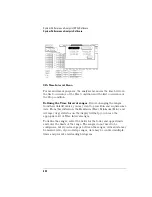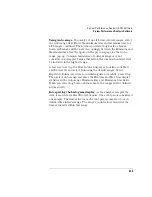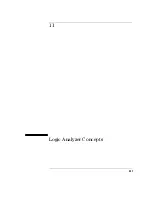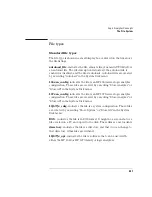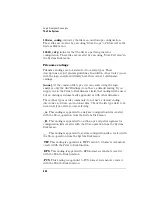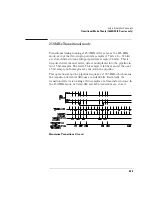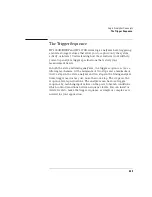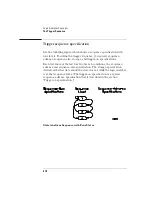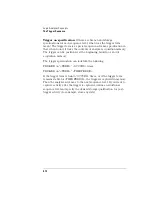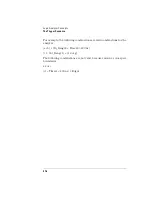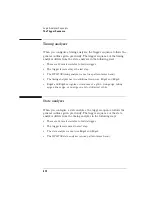
403
Logic Analyzer Concepts
Transitional Mode Theory (1660E/ES/EP-series only)
Transitional Mode Theory (1660E/ES/EP-series
only)
In Transitional acquisition mode, the timing analyzer samples data at
regular intervals, but only stores data when there is a transition
between logic levels on currently assigned bits of a pod pair. Each time
a level transition occurs on any of the bits, all bits of the pod pair are
stored. A time tag is stored with each stored data sample so the
measurement can be reconstructed and displayed later.
One issue when using transitional timing is how many transitions can
be stored. The number depends on the mode and frequency of
transition occurrence. The following overview explains the number of
transitions stored for each transitional timing mode and why.
125-MHz Transitional mode
When the timing analyzer runs in the 125-MHz mode, it operates like
the state analyzer with Count Time turned on, the exceptions being
that the store qualification comes from transition detectors instead of
the sequencer and that the analyzer uses an internal clock.
With 4 K of memory per channel and Count Time selected, the analyzer
uses half its memory (2 K) to store time tags. Because each pod pair
must store transitions at its own rate, each pod pair must store its own
set of time tags. This is why you do not have the option of using a free
pod to retain full memory as you have in the normal state mode.
When a transition is detected after a sample with no detected
transition, both samples are stored. If the next sample also indicates a
transition, only one sample is stored. If the next sample does not
indicate a transition, no sample is stored this time and the next
transition again stores two samples.
Summary of Contents for 1670E Series
Page 6: ...6 In This Book...
Page 26: ...26 Contents...
Page 27: ...27 Section 1 Logic Analyzer...
Page 28: ...28...
Page 29: ...29 1 Logic Analyzer Overview...
Page 39: ...39 2 Connecting Peripherals...
Page 49: ...49 3 Using the Logic Analyzer...
Page 72: ...72 Using the Logic Analyzer The Inverse Assembler...
Page 73: ...73 4 Using the Trigger Menu...
Page 101: ...101 5 Using the Oscilloscope...
Page 151: ...151 6 Using the Pattern Generator...
Page 199: ...199 7 Triggering Examples...
Page 237: ...237 8 File Management...
Page 249: ...249 9 Logic Analyzer Reference...
Page 360: ...360 Logic Analyzer Reference The Compare Menu...
Page 361: ...361 10 System Performance Analysis SPA Software...
Page 397: ...397 11 Logic Analyzer Concepts...
Page 430: ...430 Logic Analyzer Concepts The Analyzer Hardware Oscilloscope board theory Oscilloscope board...
Page 439: ...439 12 Troubleshooting the Logic Analyzer...
Page 455: ...455 13 Specifications...
Page 471: ...471 14 Operator s Service...
Page 479: ...479 Operator s Service Troubleshooting Troubleshooting Flowchart 2...
Page 491: ...491 Section 2 LAN...
Page 492: ...492...
Page 493: ...493 15 Introducing the LAN Interface...
Page 497: ...497 16 Connecting and Configuring the LAN...
Page 506: ...506 Connecting and Configuring the LAN Connecting and Configuring the LAN...
Page 507: ...507 17 Accessing the Logic Analyzer File System Using the LAN...
Page 515: ...515 18 Using the LAN s X Window Interface...
Page 527: ...527 19 Retrieving and Restoring Data Using the LAN...
Page 539: ...539 20 Programming the Logic Analyzer Using the LAN...
Page 546: ...546 Programming the Logic Analyzer Using the LAN Programming the Logic Analyzer Using the LAN...
Page 547: ...547 21 LAN Concepts...
Page 555: ...555 22 Troubleshooting the LAN Connection...
Page 580: ...580 Troubleshooting the LAN Connection Getting Service Support...
Page 581: ...581 Section 3 Symbol Utility...
Page 582: ...582...
Page 583: ...583 23 Symbol Utility Introduction...
Page 588: ...588 Symbol Utility Introduction Symbol Utility Introduction...
Page 589: ...589 24 Getting Started with the Symbol Utility...
Page 597: ...597 25 Using the Symbol Utility...
Page 609: ...609 26 Symbol Utility Features and Functions...




